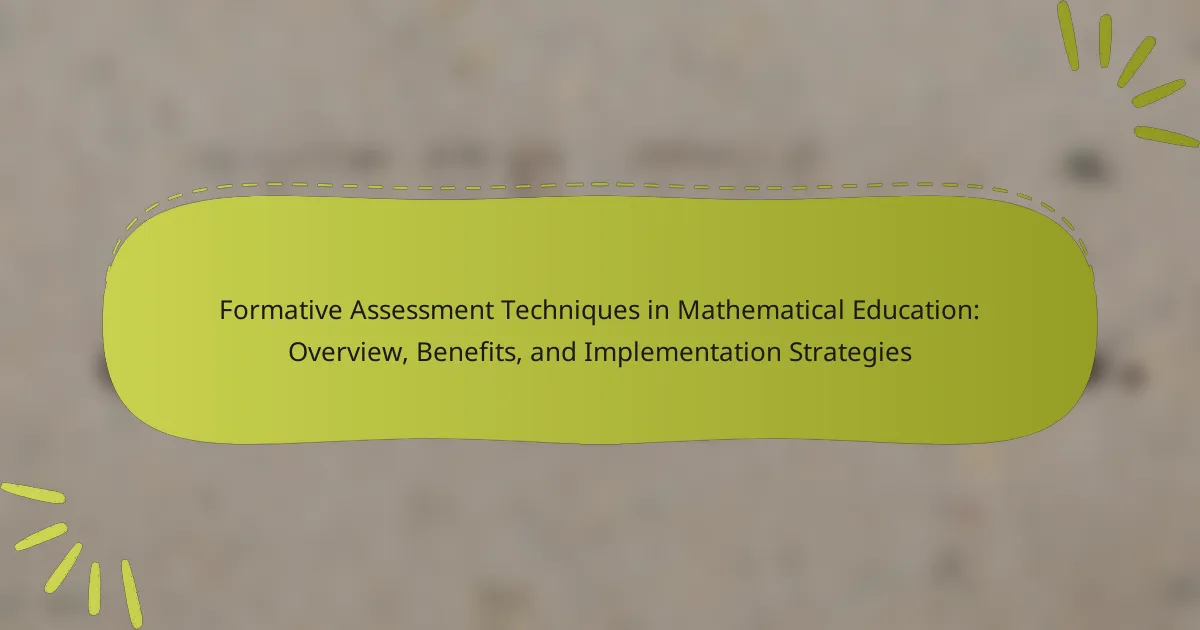Rubrics for math assessments are structured tools designed to evaluate student performance based on specific criteria. This article outlines the design principles of math rubrics, including types such as analytic, holistic, and developmental rubrics, each serving distinct assessment purposes. Key evaluation criteria discussed include clarity of understanding, accuracy of calculations, and problem-solving strategies. Research findings highlight the benefits of using well-defined rubrics, demonstrating their effectiveness in enhancing student performance and self-assessment skills. The article provides a comprehensive overview of how rubrics can improve grading consistency and student understanding of expectations in mathematics.

What are Rubrics for Math Assessments?
Rubrics for math assessments are structured tools that outline criteria for evaluating student performance. They provide specific guidelines on how to assess various aspects of math assignments or tests. Rubrics typically include categories such as understanding of concepts, problem-solving skills, and accuracy of answers. Each category may have defined levels of performance, ranging from excellent to poor. This structure helps ensure consistency in grading. Research shows that using rubrics can enhance student understanding of expectations. A study by Andrade and Du (2005) found that rubrics improve student performance and self-assessment skills.
How do Rubrics enhance Math Assessments?
Rubrics enhance math assessments by providing clear criteria for evaluation. They outline specific expectations for student performance. This clarity helps students understand what is required to succeed. Rubrics also promote consistency in grading among different assessors. Research shows that using rubrics can improve student learning outcomes. A study by Andrade (2000) found that students who received rubric feedback performed better on assessments. Rubrics facilitate targeted feedback, helping students identify areas for improvement. They encourage self-assessment and reflection, fostering a growth mindset. Overall, rubrics make the assessment process more transparent and effective.
What are the key components of effective Rubrics?
Key components of effective rubrics include clarity, specific criteria, descriptive levels of performance, and alignment with learning objectives. Clarity ensures that all users understand the expectations. Specific criteria outline what is being assessed, providing a clear framework for evaluation. Descriptive levels of performance detail varying degrees of achievement, aiding in objective grading. Alignment with learning objectives ensures that the rubric measures the intended skills and knowledge. These components contribute to a fair and consistent assessment process in educational settings.
How do Rubrics support student learning and assessment?
Rubrics support student learning and assessment by providing clear criteria for evaluating performance. They outline specific expectations for assignments and projects. This clarity helps students understand what is required to succeed. Rubrics also promote consistency in grading, ensuring fairness across different evaluators. They can guide students in self-assessment, encouraging reflection on their work. Research shows that rubrics can enhance learning outcomes by helping students identify areas for improvement. According to a study by Andrade and Du (2005), students who use rubrics tend to perform better due to increased understanding of assessment criteria. Overall, rubrics are effective tools for enhancing both learning and assessment in educational settings.
Why are Design Principles important in Rubric creation?
Design principles are important in rubric creation because they ensure clarity and consistency. Clear design principles help articulate expectations for both educators and students. They guide the development of assessment criteria that are understandable and measurable. Consistent application of these principles enhances fairness in evaluation. Research indicates that well-structured rubrics improve student performance by providing specific feedback. The National Council of Teachers of Mathematics emphasizes that effective rubrics align with learning objectives. This alignment is crucial for assessing student understanding accurately. Overall, design principles enhance the reliability and validity of the assessment process.
What are the foundational Design Principles for Math Rubrics?
The foundational design principles for math rubrics include clarity, alignment, and consistency. Clarity ensures that the criteria are understandable to both students and educators. Alignment refers to the connection between the rubric and learning objectives or standards. Consistency guarantees that assessments yield similar results across different evaluators. These principles enhance the effectiveness of rubrics in accurately measuring student performance. Research has shown that clear and aligned rubrics improve student understanding and achievement in mathematics.
How do Design Principles impact the clarity of Rubrics?
Design principles significantly enhance the clarity of rubrics. Clear design principles, such as consistency and simplicity, make rubrics easier to understand. When a rubric follows a logical structure, it aids in comprehension. Visual elements like spacing and typography also contribute to clarity. Research shows that well-designed rubrics improve student performance by providing clear expectations. According to a study by Brookhart (2013), clarity in rubrics directly correlates with student understanding and self-assessment. Thus, effective design principles are crucial for creating clear and functional rubrics.

What are the different Types of Math Assessment Rubrics?
The different types of math assessment rubrics include analytic, holistic, and developmental rubrics. Analytic rubrics assess specific criteria separately. They provide detailed feedback on each aspect of performance. Holistic rubrics evaluate overall performance with a single score. They are quicker to use but less detailed. Developmental rubrics track progress over time. They focus on growth in skills rather than just end results. Each type serves different assessment purposes and offers unique insights into student performance.
How do Holistic and Analytic Rubrics differ?
Holistic rubrics assess student work as a whole, while analytic rubrics break down performance into specific criteria. Holistic rubrics provide a single score based on overall quality. Analytic rubrics assign separate scores for each criterion, offering detailed feedback. This means holistic rubrics are simpler and quicker to use. Analytic rubrics take more time to evaluate but give richer information. Research shows that analytic rubrics can enhance student learning by clarifying expectations. Thus, the key difference lies in their structure and the depth of feedback provided.
What are the advantages of using Holistic Rubrics?
Holistic rubrics offer several advantages in assessment. They provide a comprehensive evaluation of student performance. This approach allows for quicker grading, as it assesses overall understanding rather than individual components. Holistic rubrics promote consistency in grading across different evaluators. They help students understand the overall expectations and criteria for success. Additionally, they encourage a focus on higher-order thinking skills. Research indicates that holistic rubrics can enhance student motivation by clarifying learning goals. Overall, they streamline the assessment process while providing valuable feedback.
What are the advantages of using Analytic Rubrics?
Analytic rubrics provide clear criteria for assessment. They break down performance into specific components. This helps educators identify strengths and weaknesses in student work. Each criterion is evaluated separately, allowing for detailed feedback. Analytic rubrics enhance objectivity in grading. They reduce subjectivity by providing standardized measures. Research shows that students benefit from understanding expectations. Clarity in assessment criteria leads to improved student performance.
What are some examples of specific Rubric Types for Math Assessments?
Analytic rubrics, holistic rubrics, and developmental rubrics are examples of specific rubric types for math assessments. Analytic rubrics assess multiple criteria separately, offering detailed feedback. Holistic rubrics provide a single score based on overall performance, simplifying evaluation. Developmental rubrics track student progress over time, emphasizing growth in specific skills. Each type serves distinct purposes in evaluating mathematical understanding and skills.
How can Performance Task Rubrics be structured?
Performance task rubrics can be structured by defining clear criteria and performance levels. Each rubric typically includes categories that outline specific skills or knowledge areas. These categories can be broken down into performance descriptors that indicate varying levels of mastery. For instance, descriptors may range from “exemplary” to “needs improvement.”
Additionally, a scoring system can be implemented to quantify performance levels. This system often uses a point scale, such as 1 to 4, to assign values to each level of performance. Clear examples or samples of student work can enhance understanding of expectations.
Incorporating feedback mechanisms within the rubric allows for constructive comments on student performance. Research indicates that well-structured rubrics improve assessment reliability and clarity (Andrade, 2000; “Using Rubrics to Promote Thinking and Learning,” Educational Leadership).
What features define a Collaborative Assessment Rubric?
A Collaborative Assessment Rubric is defined by its focus on teamwork and shared evaluation criteria. It promotes collective input from students and educators in the assessment process. This rubric often includes multiple dimensions of performance, allowing for diverse feedback. It typically features clear descriptors for each level of achievement. The use of peer assessment is a common characteristic, fostering collaboration among students. Additionally, it encourages reflection on both individual and group contributions. Collaborative Assessment Rubrics are designed to enhance communication skills and critical thinking. Research indicates that such rubrics improve student engagement and accountability in learning environments.

What Evaluation Criteria should be considered in Math Rubrics?
Evaluation criteria in math rubrics should include clarity of understanding, accuracy of calculations, and problem-solving strategies. Clarity of understanding assesses if students grasp mathematical concepts. Accuracy of calculations evaluates the correctness of numerical answers. Problem-solving strategies focus on the methods used to arrive at solutions. Additionally, criteria may involve communication of mathematical reasoning and the application of concepts to real-world situations. These criteria ensure a comprehensive evaluation of a student’s mathematical abilities. Research indicates that well-defined rubrics improve student performance by providing clear expectations (Brookhart, 2013).
How do we determine the effectiveness of Evaluation Criteria?
The effectiveness of evaluation criteria is determined by their alignment with learning objectives. Criteria must clearly reflect the skills and knowledge intended to be assessed. They should be specific, measurable, and relevant to the subject matter. Feedback from students and educators can provide insights into the clarity and applicability of the criteria. Additionally, analyzing student performance data can reveal whether the criteria accurately differentiate levels of understanding. Consistency in applying the criteria across different assessments enhances reliability. Research indicates that well-defined criteria improve student outcomes and engagement. For example, a study by Andrade (2000) found that students who understood evaluation criteria performed better in assessments.
What role do clear descriptors play in Evaluation Criteria?
Clear descriptors in evaluation criteria provide specific guidance on performance expectations. They enhance clarity and transparency in assessment. Clear descriptors help students understand what is required to achieve different performance levels. They also facilitate consistent and objective grading by evaluators. Research indicates that well-defined descriptors improve student performance and engagement. For instance, studies show that students perform better when they know the criteria for success. This understanding leads to more focused learning efforts. Clear descriptors ultimately contribute to fairer and more effective assessments in educational settings.
How can Evaluation Criteria be aligned with learning objectives?
Evaluation criteria can be aligned with learning objectives by ensuring that both are clearly defined and directly related. First, learning objectives should articulate specific skills or knowledge that students are expected to acquire. Next, evaluation criteria must reflect these objectives in measurable terms. This alignment ensures that assessments accurately gauge student understanding of the intended learning outcomes.
For example, if a learning objective is to solve quadratic equations, the evaluation criteria should include specific problem-solving steps and accuracy in solutions. Research shows that well-aligned evaluation criteria lead to improved student performance and clarity in expectations. A study by Brookhart (2013) indicates that clear alignment enhances student motivation and achievement.
What are common challenges in creating effective Rubrics?
Common challenges in creating effective rubrics include ambiguity in criteria, lack of alignment with learning objectives, and difficulty in ensuring consistency. Ambiguous criteria can lead to varied interpretations among evaluators. This inconsistency affects the reliability of assessments. Lack of alignment with learning objectives can result in rubrics that do not accurately measure student performance. Furthermore, ensuring consistency in application across different assessors can be challenging. In fact, research shows that poorly defined rubrics can lead to a 30% variance in grading outcomes among different evaluators. These challenges highlight the need for clear, specific, and aligned rubric design.
How can educators overcome these challenges?
Educators can overcome challenges in math assessments by implementing clear and consistent rubrics. These rubrics should align with learning objectives and provide specific criteria for evaluation. Training educators on effective rubric design enhances their ability to assess student performance accurately. Regularly reviewing and updating rubrics based on student feedback can improve their effectiveness. Collaborative discussions among educators can lead to shared best practices in rubric usage. Research indicates that well-designed rubrics can reduce grading time and increase student understanding of expectations. Studies show that clear feedback from rubrics positively impacts student learning outcomes.
What are best practices for implementing Rubrics in Math Assessments?
Best practices for implementing rubrics in math assessments include clear criteria, alignment with learning objectives, and consistent language. Clear criteria help students understand expectations. Aligning rubrics with learning objectives ensures assessments measure desired skills. Consistent language across the rubric promotes fairness and clarity. Additionally, involving students in rubric development enhances ownership and understanding. Providing examples of work at each level aids comprehension. Regularly reviewing and updating rubrics based on feedback improves their effectiveness. Research shows that effective rubrics can enhance student performance and engagement in math assessments.
Rubrics for math assessments are structured evaluation tools that outline specific criteria for assessing student performance in mathematical tasks. This article covers the design principles, types, and evaluation criteria essential for creating effective rubrics. Key components include clarity, alignment with learning objectives, and consistency to enhance grading fairness and transparency. The article also explores various rubric types, such as analytic and holistic rubrics, and discusses common challenges in rubric creation along with best practices for implementation. Overall, it emphasizes how well-designed rubrics can significantly improve student learning outcomes and assessment accuracy.



